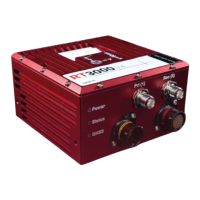Oxford Technical Solutions Ltd Page 64 of 110
The Navigation tab is where navigation-related CAN messages are configured for output. The table can be
sorted in ascending or descending order by clicking any column header. This is particularly useful when
checking for enabled/disabled messages.
Figure 32: NAVconfig CAN output configuration tab - Navigation
Each message can be enabled/disabled by clicking in the appropriate cell and selecting from the dropdown
menu. The message Identifier is also changed by clicking in the cell. The identifier number should be defined in
either hexadecimal or decimal format. Decimal values can be entered as normal. Hexadecimal values should
have a letter “h” appended.
The Data rate can be set using the dropdown list that appears after clicking in each data rate cell. When a
message’s data rate changes or it is enabled or disabled, the caption at the bottom of the window displaying
messages per second updates to reflect the new settings.
The Enabled checkbox quickly enables and disables all messages.
The Status tab lists all status messages, which are sent one after another in a repeating loop. Although 80
messages are shown in the list, 100 are actually used internally. If the data rate is set to 100 Hz, a status
message will be sent every 10 ms. Some messages are transmitted more frequently than others because they

